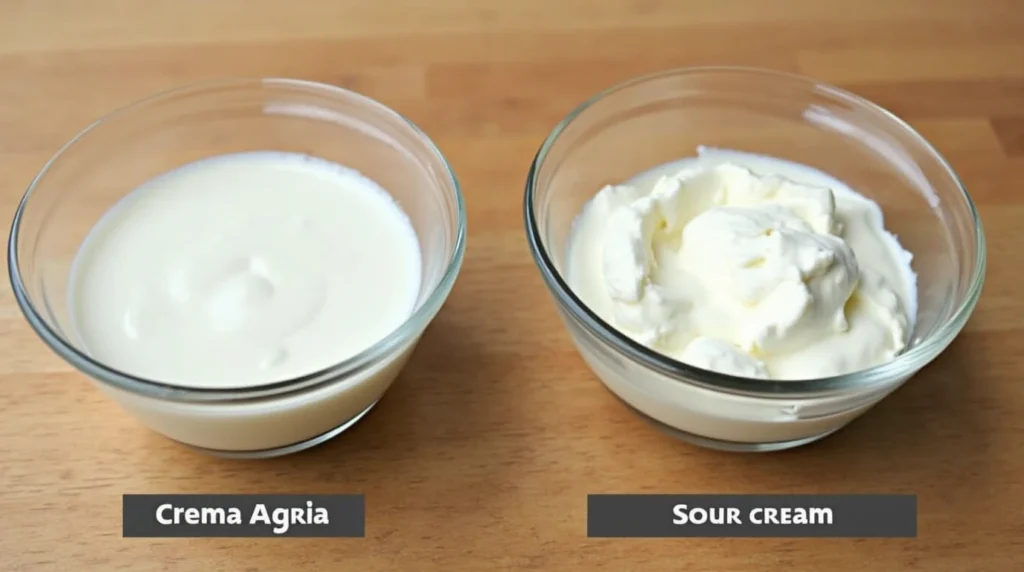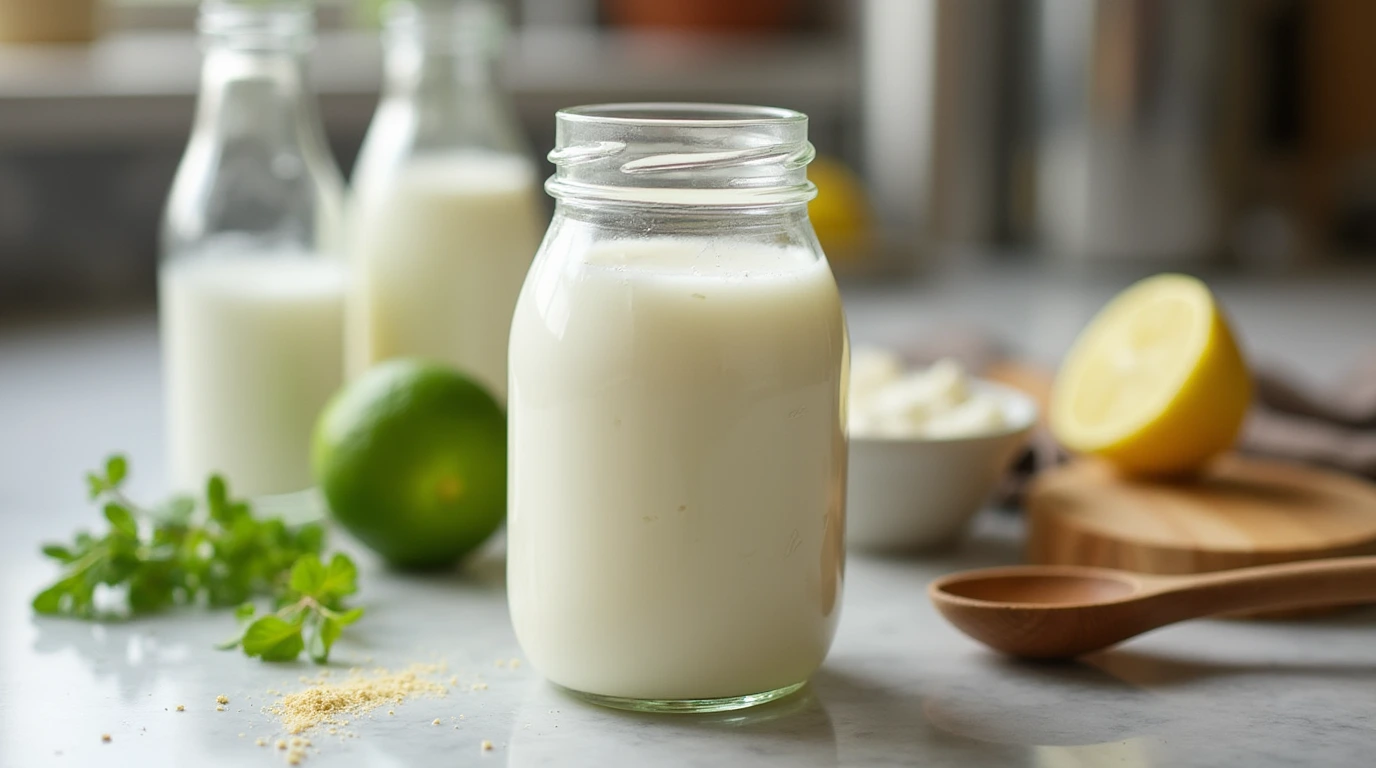Crema agria: How to Make it at Home in 5 Simple Steps
Introduction
Crema agria, often known as Mexican sour cream, offers a buttery richness with a subtle tang that elevates everything from morning eggs to evening enchiladas. Unlike its American counterpart, crema agria has a thicker consistency and a more complex flavor profile that can take your home cooking to new heights. Whether you’re a seasoned chef or a curious foodie, understanding this ingredient is your ticket to more authentic and delicious Mexican-inspired meals.

Table of Contents

Homemade Crema Agria
Equipment
- Clean glass jar with lid
- Thermometer (optional)
- Cheesecloth (optional, for thicker consistency)
Ingredients
- 2 cups heavy cream preferably not ultra-pasteurized
- 3 tablespoons buttermilk with active cultures
- 1 tablespoon fresh lime juice
- 1/4 teaspoon fine sea salt
Instructions
- Warm the heavy cream to about 75°F (24°C).
- Pour the warm cream into a glass jar and add the buttermilk.
- Stir in the lime juice and salt.
- Cover the jar loosely to allow gases to escape.
- Let it ferment at room temperature (70-75°F) for 12-24 hours.
- Check for a tangy aroma and thick consistency.
- Refrigerate to stop fermentation.
- Optionally, strain through cheesecloth for a thicker texture.
Notes
- The warmer the kitchen, the faster it cultures.
- Best flavor within the first 4-5 days.
- Store in the fridge for up to a week.
What Exactly Is Crema Agria?
When I first encountered crema agria, I mistakenly thought it was just “foreign sour cream.” Boy, was I wrong! Crema agria stands in a category of its own, bringing unique characteristics to the table that distinguish it from other cultured cream products.
Crema agria, such as the popular Cacique Crema Mexicana Agria, is a cultured dairy product with origins in Mexican cuisine. The word “agria” literally means “sour” in Spanish, but don’t let that fool you—this isn’t your typical sour cream. What makes crema agria special is its perfect balance of richness and tanginess. It has a more buttery flavor than regular sour cream, with just enough acidity to cut through heavy dishes without overwhelming them.
Crema Agria vs. Regular Sour Cream: Understanding the Differences
Flavor Profile
The most noticeable difference lies in the flavor. Regular sour cream offers a straightforward tanginess that most Americans are familiar with. Crema agria, however, brings a more complex profile to the table—it’s simultaneously richer, slightly less sour, and has distinct buttery notes that regular sour cream lacks. This subtle complexity is why many chefs prefer crema agria for recipes where the cream plays a prominent role.

Nutritional Differences
From a nutritional standpoint, crema agria typically contains more fat than regular sour cream, contributing to its richer mouthfeel and flavor. A typical serving of crema agria might contain around 30% fat, compared to about 20% in regular sour cream. This higher fat content also means it carries slightly more calories per serving.
Here’s a quick comparison table to illustrate the key differences:
| Characteristic | Crema Agria | Regular Sour Cream |
| Flavor | Buttery with mild tanginess | Pronounced sour taste |
| Texture | Pourable, smoother | Thicker, spoonable |
| Fat Content | Typically higher (around 30%) | Lower (around 20%) |
| Heat Stability | More stable, less likely to curdle | Prone to curdling when heated |
| Primary Uses | Versatile: toppings, cooking, sauces | Primarily cold applications |
The Nutritional Profile of Crema Agria
Cacique Crema Mexicana Agria, like most dairy products, contains a mix of nutrients that can be part of a healthy eating pattern when consumed in moderation. Here’s what you’ll typically find in a two-tablespoon serving:
- Calories: Approximately 60-70 calories
- Fat: About 6-7 grams, with roughly 4 grams being saturated fat
- Protein: 1-2 grams
- Carbohydrates: 1-2 grams
- Calcium: Roughly 4-6% of your daily recommended intake
Popular Brands and Where to Find Them
Top Brands to Consider
1. Cacique Crema Mexicana Agria Undoubtedly the market leader, Cacique has become almost synonymous with crema agria in many parts of the United States. Their Crema Mexicana Agria offers consistent quality and authentic flavor that has made it the go-to choice for home cooks and professional chefs alike. What I particularly appreciate about Cacique’s product is its perfect balance of thickness and pourability—it stands up well in both cold and hot applications.
2. La Vaquita Another excellent option, La Vaquita produces a crema agria that tends to be slightly thicker than Cacique’s. This makes it especially good for dishes where you want the cream to sit on top rather than be absorbed.
3. El Mexicano El Mexicano’s version has a particularly rich, buttery flavor that some cooks prefer for certain applications. I find their product works beautifully in creamy sauces.
4. Lala Popular in many Hispanic communities, Lala offers a slightly tangier version that more closely resembles traditional homemade crema agria. This is my personal favorite when making ceviches or light summer dishes.
5. Alpura Less common but worth seeking out, Alpura’s crema agria has a distinctive flavor profile that some culinary enthusiasts particularly enjoy for specific regional Mexican dishes.
Culinary Uses: Traditional Mexican Applications
Tacos and Tostadas
Perhaps the most familiar application for many, a drizzle of crema agria across tacos or tostadas provides the perfect cooling counterpoint to spicy fillings. Unlike regular sour cream, Cacique Crema Mexicana Agria doesn’t immediately melt away when it touches hot ingredients, allowing it to maintain its integrity while still integrating with the other flavors.
My favorite application is on fish tacos—the buttery notes in the crema agria complement the delicate seafood perfectly, while its tanginess cuts through the richness of fried batter. For an elevated touch, mix the crema agria with a bit of lime zest and a pinch of chile powder before dolloping it on.
Enchiladas
Traditional enchiladas often feature crema agria either mixed into the sauce for added richness or drizzled over the top just before serving. The heat-stable nature of crema agria makes it particularly suitable for this application, as it doesn’t break down or curdle when exposed to the hot enchilada sauce.
I particularly love using crema agria with enchiladas verdes, where the tanginess of the cream beautifully complements the tart tomatillo sauce. It adds a luxurious mouthfeel that transforms the dish from good to memorable.
Elote (Mexican Street Corn)
This beloved street food showcases crema agria in all its glory. Traditional elote consists of grilled corn on the cob slathered with a mixture of crema agria, mayonnaise, chile powder, lime juice, and cotija cheese. The crema agria acts as both a binding agent and a flavor enhancer, helping the other ingredients adhere to the corn while adding its distinctive tangy richness.

I’ve found that using crema agria instead of regular sour cream in elote gives the final dish a more authentic flavor and superior texture—it clings to the corn better without being too heavy.
Chiles Rellenos
In this classic dish of stuffed, battered, and fried poblano peppers, crema agria serves as both an ingredient and a garnish. Mixed into the tomato sauce that typically accompanies chiles rellenos, it adds body and tempers the acidity. Drizzled over the top, it provides a cool contrast to the warm pepper and a creamy counterpoint to the savory filling.
Soups and Stews
Many traditional Mexican soups, from pozole to sopa de tortilla, benefit from a generous swirl of crema agria. Unlike regular sour cream, which might curdle in hot liquids, crema agria maintains its creamy texture while adding richness and tempering spiciness.
One of my favorite applications is in a simple black bean soup—the contrast between the earthy beans and the bright, creamy swirl of crema agria creates a perfect balance of flavors and textures.
Making Your Own Crema Agria at Home
While Cacique Crema Mexicana Agria and other commercial brands offer convenience and consistency, there’s something deeply satisfying about making your own crema agria at home. I’ve spent years perfecting my homemade version, and I’m excited to share this process with you. Not only does it allow you to control the ingredients, but the flavor of freshly made crema agria is truly unparalleled.
Basic Homemade Crema Agria Recipe
Ingredients:
- 2 cups heavy cream (preferably not ultra-pasteurized)
- 3 tablespoons buttermilk (with active cultures)
- 1 tablespoon fresh lime juice
- 1/4 teaspoon fine sea salt
Equipment:
- Clean glass jar with lid
- Thermometer (optional but helpful)
- Cheesecloth (optional, for thicker crema)
Instructions:
- In a small saucepan, gently warm the heavy cream to about 75°F (24°C)—just slightly above room temperature. This helps activate the cultures without killing them. If you don’t have a thermometer, the cream should feel barely warm to the touch.
- Pour the warm cream into a clean glass jar and add the buttermilk, which contains the active cultures that will transform your cream.
- Stir in the lime juice and salt, mixing gently until combined.
- Cover the jar with its lid, but don’t tighten it completely—the fermentation process produces gases that need to escape.
- Let the mixture sit at room temperature (around 70-75°F or 21-24°C) for 12-24 hours. The warmer your kitchen, the faster it will culture.
- Check the crema agria periodically—you’ll know it’s ready when it’s thickened slightly and has developed a pleasant tangy aroma. It should coat the back of a spoon but still be pourable.
- Once it reaches your desired consistency and tanginess, refrigerate it to halt the fermentation process. The crema agria will continue to thicken somewhat in the refrigerator.
- For an even thicker consistency, you can strain the crema through a cheesecloth-lined strainer for a few hours in the refrigerator.
Your homemade crema agria will keep in the refrigerator for up to one week, though I find the flavor is best within the first 4-5 days.
Troubleshooting Homemade Crema Agria
Making cultured dairy products at home can sometimes be unpredictable. Here are some common issues and how to address them:
Too Thin: If your crema hasn’t thickened properly, it may need more time to culture. You can also try adding a bit more buttermilk next time for stronger bacterial action.
Too Thick: If your crema agria is thicker than the pourable consistency you’re looking for, simply whisk in a small amount of milk or cream until you reach your desired texture.
Off Flavors: If your crema develops any unpleasant or overly sour flavors, it may have cultured too long or been contaminated. Make sure all your equipment is very clean, and reduce the fermentation time in warm weather.
Separation: Some separation is normal and can be fixed with gentle stirring. However, if the cream fully separates into solid and liquid components, the culturing environment may have been too warm.
Flavor Variations
Once you’ve mastered the basic recipe, don’t be afraid to experiment with flavor variations. Some of my favorites include:
- Herb-Infused: Add crushed garlic and fresh herbs like cilantro or chives after culturing
- Spicy: Mix in finely chopped jalapeños or a touch of chile powder
- Citrusy: Increase the lime juice and add some fresh zest after culturing
- Smoky: Incorporate a small amount of chipotle powder for a smoky kick
Homemade crema agria allows for customization that you simply can’t get with store-bought varieties like Cacique Crema Mexicana Agria. While commercial products offer consistency and convenience, the satisfaction of creating your own cultured dairy product is hard to beat.

Recipes Showcasing Crema Agria
Now that we’ve covered what crema agria is, how it differs from other dairy products, and how to store it properly, let’s put this knowledge into delicious practice! I’ve selected some of my favorite recipes that highlight the unique properties of crema agria, from traditional Mexican classics to innovative fusion dishes. Each recipe showcases how Cacique Crema Mexicana Agria or other brands of crema agria can elevate everyday cooking.
Creamy Poblano Soup (Crema de Poblano)
This velvety soup showcases crema agria’s ability to create silky textures while adding subtle tanginess.
Ingredients:
- 6 poblano peppers, roasted, peeled, and seeded
- 1 tablespoon olive oil
- 1 medium onion, chopped
- 3 cloves garlic, minced
- 4 cups chicken or vegetable broth
- 1 cup Cacique Crema Mexicana Agria
- 1/2 cup chopped cilantro, plus more for garnish
- Salt and pepper to taste
- Toasted pepitas for garnish
Instructions:
- Heat olive oil in a large pot over medium heat. Add onions and sauté until translucent, about 5 minutes.
- Add garlic and cook for another minute until fragrant.
- Add roasted poblanos and broth. Bring to a simmer and cook for 10 minutes.
- Transfer to a blender (in batches if necessary) and purée until smooth.
- Return soup to pot and reduce heat to low. Stir in crema agria and cilantro, heating gently without boiling.
- Season with salt and pepper to taste.
- Serve garnished with additional cilantro and toasted pepitas.
Cilantro-Lime Crema Agria (Versatile Condiment)
This simple preparation transforms crema agria into a versatile condiment that enhances everything from tacos to grilled meats.
Ingredients:
- 1 cup crema agria
- Zest and juice of 1 lime
- 1/4 cup finely chopped cilantro
- 1 small garlic clove, very finely minced (optional)
- 1/2 teaspoon ground cumin
- Salt to taste
- Pinch of cayenne pepper (optional)
Instructions:
- Combine all ingredients in a bowl and whisk until well incorporated.
- Allow flavors to meld in the refrigerator for at least 30 minutes before serving.
- Store in an airtight container for up to 5 days.
This condiment is perfect for drizzling over tacos, burritos, grilled fish, roasted vegetables, or using as a dip for fresh vegetables.
Mexican Street Corn Salad (Esquites) with Crema Agria
This deconstructed version of elote makes for a perfect side dish or potluck contribution.
Ingredients:
- 6 ears corn, husked
- 2 tablespoons vegetable oil
- 1/2 cup crema agria
- 1/4 cup mayonnaise
- 1/2 cup crumbled cotija cheese, plus more for garnish
- 1/4 cup chopped cilantro
- 2 tablespoons lime juice
- 1 teaspoon chile powder, plus more for garnish
- 1/2 teaspoon ground cumin
- Salt to taste
- 1 jalapeño, seeded and finely diced
Instructions:
- Grill or roast corn until charred in spots. Let cool slightly, then cut kernels from cobs.
- In a large bowl, whisk together crema agria and mayonnaise until smooth.
- Add cotija, cilantro, lime juice, chile powder, cumin, and salt. Mix well.
- Fold in corn kernels and jalapeño.
- Garnish with additional cotija cheese and a sprinkle of chile powder before serving.
Crema Agria Enchiladas Verdes
These enchiladas feature crema agria both in the sauce and as a topping, showcasing its versatility.
Ingredients:
- 12 corn tortillas
- 2 cups cooked, shredded chicken
- 1 cup shredded Monterey Jack cheese
- 1/2 cup diced white onion
For the sauce:
- 1.5 pounds tomatillos, husked and rinsed
- 2 jalapeños, stemmed
- 1/2 cup cilantro leaves
- 2 garlic cloves
- 1/2 cup chicken broth
- 1/2 cup crema agria
- Salt to taste
For serving:
- 1/2 cup crema agria for drizzling
- 1/4 cup crumbled cotija cheese
- 1/4 cup chopped cilantro
Instructions:
- Roast tomatillos and jalapeños under broiler until charred, about 5-7 minutes, turning once.
- Transfer to blender with cilantro, garlic, and chicken broth. Blend until smooth.
- Pour sauce into a saucepan and simmer for 10 minutes. Remove from heat and stir in 1/2 cup crema agria.
- Preheat oven to 375°F.
- Warm tortillas until pliable. Dip each in sauce, fill with chicken, roll, and place in baking dish.
- Pour remaining sauce over enchiladas and sprinkle with Monterey Jack cheese.
- Bake for 20-25 minutes until bubbling and cheese is melted.
- Drizzle with additional crema agria and sprinkle with cotija cheese and cilantro before serving.
Crema Agria Pound Cake with Berry Compote
This unexpected dessert application showcases crema agria’s ability to create moist, tender baked goods with a subtle tang.
Ingredients: For the cake:
- 1 1/2 cups all-purpose flour
- 1/2 teaspoon baking powder
- 1/4 teaspoon baking soda
- 1/4 teaspoon salt
- 1/2 cup (1 stick) unsalted butter, softened
- 1 cup granulated sugar
- 2 large eggs
- 1 teaspoon vanilla extract
- 1/2 cup crema agria
- Zest of one lemon
For the berry compote:
- 2 cups mixed berries (strawberries, blueberries, raspberries)
- 1/3 cup sugar
- 1 tablespoon lemon juice
- 1/4 cup crema agria for serving
Instructions:
- Preheat oven to 325°F. Grease and flour a 9×5-inch loaf pan.
- Whisk together flour, baking powder, baking soda, and salt.
- In another bowl, cream butter and sugar until light and fluffy.
- Beat in eggs one at a time, then vanilla and lemon zest.
- Alternately add flour mixture and crema agria, beginning and ending with flour.
- Pour batter into prepared pan and bake for 55-60 minutes until a toothpick comes out clean.
- For compote, combine berries, sugar, and lemon juice in a saucepan. Cook over medium heat until berries break down and mixture thickens slightly, about 10 minutes.
- Serve cake slices with warm berry compote and a dollop of crema agria.
Frequently Asked Questions (FAQs)
- What is Crema Agria?
Crema Agria, such as Cacique’s Crema Mexicana Agria, is a type of sour cream with a rich, buttery flavor and a slight acidic tang.
- How do I use Crema Agria in cooking?
It can be used as a topping or base in savory dishes, often poured or dolloped.
- Can Crema Agria be whipped?
No, Crema Agria does not whip well due to its thick consistency.
- Is Crema Agria gluten-free?
Yes, Cacique’s Crema Mexicana Agria is gluten-free.
- Can I substitute Crema Agria for regular sour cream?
Yes, it can be used as a substitute, but it has a richer flavor.
- What are the nutritional benefits of Crema Agria?
It contains calories, fat, and some protein, with minimal carbohydrates.
- How do I store Crema Agria?
It should be stored in the refrigerator to maintain freshness.
- Can Crema Agria be used in desserts?
While possible, its savory flavor makes it more suitable for savory dishes.
- Is Crema Agria lactose-free?
No, Cacique does not offer lactose-free versions of their sour creams.
- Where can I buy Crema Agria?
It is available at major retailers like H-E-B, Kroger, and Walmart.
Write a review
There are no reviews yet. Be the first one to write one.







